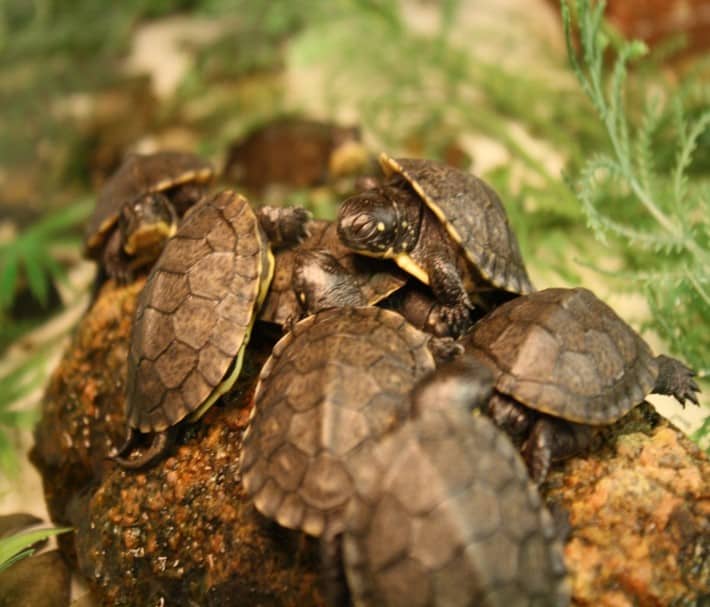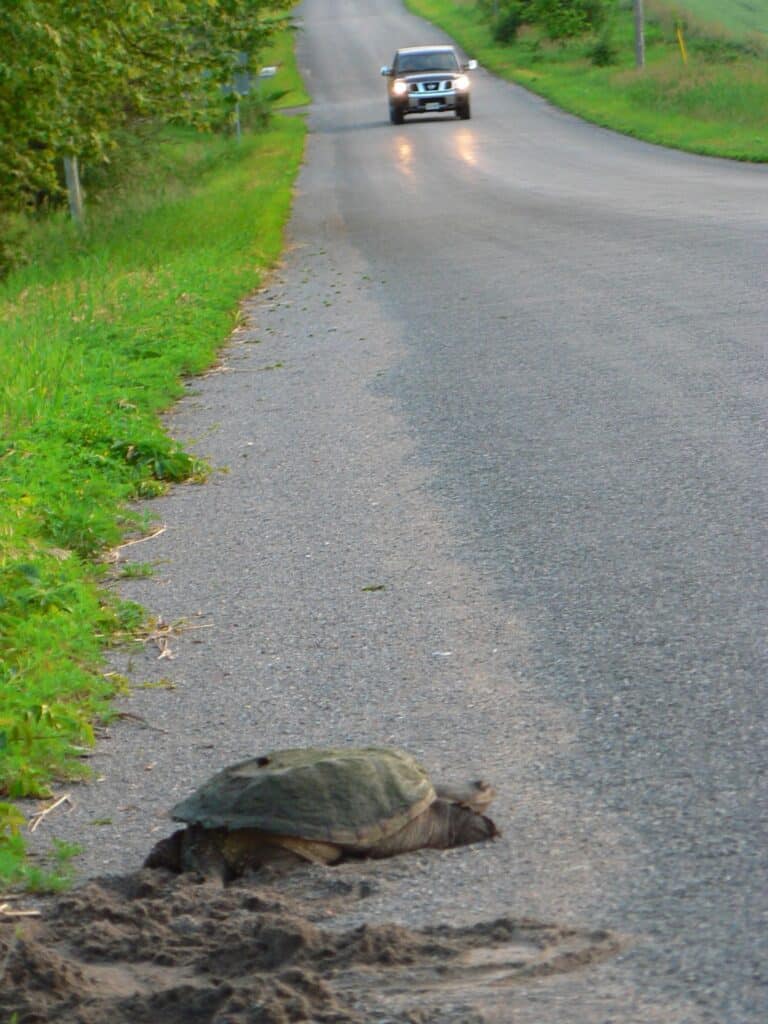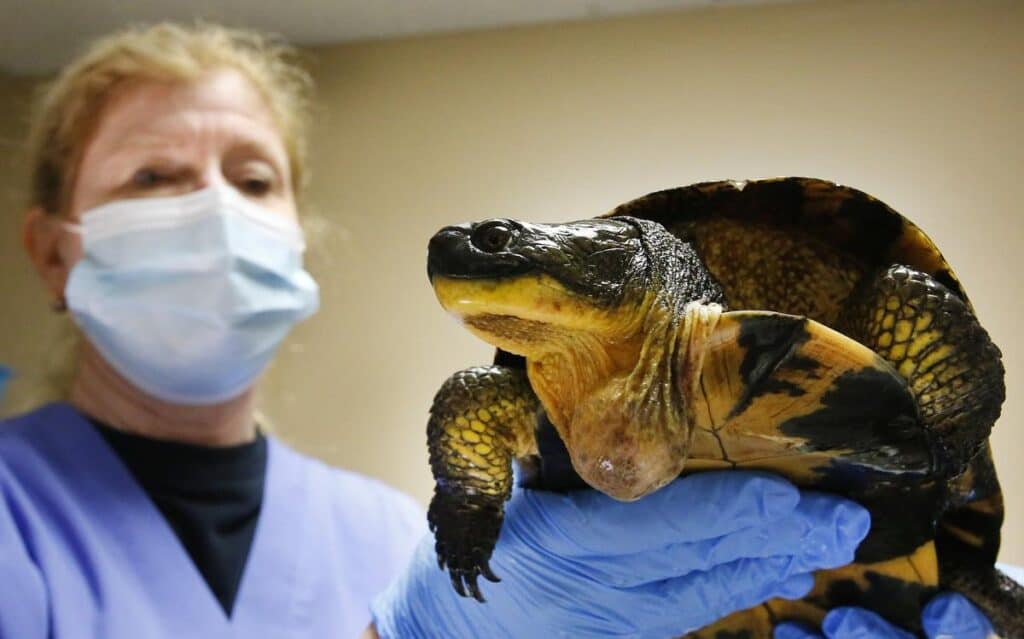With nesting season here, June is a perilous time on our roads
Peterborough Examiner – June 10, 2022 – by Drew Monkman
As I’ve written many times in this column, my love of nature began with a special fondness for turtles. As a child, I loved nothing more than catching, feeding and then releasing these wonderful creatures. But when their June nesting season rolls around each year, I’m always hyper-aware of the many threats they face and none more so than the turtle carnage on our roads.
The good news, however, is that Peterborough is home to the Ontario Turtle Conservation Centre (OTCC), an organization that’s doing internationally-respected work in mitigating the many threats our turtles face. The Centre’s hospital has already received over 600 turtles this spring which is well above any other year. As Executive and Medical Director, Dr. Susan Carstairs, told me this week, “It has been extremely challenging to keep on top of it all, especially given the limited space we have.”
Six species of native turtles can be found in Peterborough County. Of these, the painted, snapping, and Blanding’s turtles are most familiar. Their future, however, is far from certain. The Committee on Status of Species at Risk in Ontario has designated Blanding’s turtles as threatened in the province, while the snapping, eastern musk, and northern map turtles are listed as species of special concern. The situation for endangered spotted turtles is even more precarious.

Slow down
Starting in late May, female turtles begin searching out a place to lay their eggs, preferably with well-drained, loose, sandy soil or fine gravel. Both males and females also cover many kilometers in search of mates, feeding grounds, and preferred summer hangouts. Invariably, they encounter roads and traffic in their travels. This can spell disaster. Turtle mortality in June is especially devastating, since egg-bearing adult females are often the victims.
So, what can drivers do? The most important thing is to slow down and carefully watch the road surface ahead, especially when travelling near wetlands, lakes, and rivers. If you see a turtle on the road and traffic conditions are safe, consider stopping, putting on your emergency flashers, and moving the animal to the shoulder in the direction it’s heading. Another option is to simply stand guard, and let the traveler get where it’s going on its own.
If you find an injured or deceased turtle, call the OTTC at 705-741-5000. Remember to take note of the location such as the road, GPS coordinates or the distance from an intersection or a given landmark. In the case of an injured turtle, carefully place it in a well-ventilated container with a secure lid and no water. The OTCC has first responders throughout the province who have been trained in emergency turtle care. There is also a team of province-wide volunteers who help get turtles to the Centre. You should also contact the OTCC if you find a recently deceased turtle. It could have eggs that can be incubated until they hatch.
If you come across a nest that has been disturbed by a predator, carefully place the eggs back in the hole and bury them. Another option is to bring the eggs to the OTTC to be incubated. Volunteer drivers may also be able to deliver them.
If you have turtles nesting on your property, there are ways to protect the nests from threats like predators. On the OTCC website, you’ll find a brochure on best practices as well as nest protectors for sale.

OTCC is growing
The Ontario Turtle Conservation Centre, located at 4-1434 Chemong Road, is a registered charity whose goal is to protect and conserve Ontario’s native turtles and their habitat. Founded 13 years ago, it plays a huge role in mitigating the many threats facing Ontario’s turtles. The hospital helps to reverse some of the effects of road collisions by rehabilitating injured turtles and then returning them to the wild. The hatchling program returns babies hatched from hospital patients to their mothers’ wetlands, while the organization’s field work increases our knowledge of turtle populations. The education and outreach program not only addresses all of the threats our turtles face but also teaches the public how to become turtle conservation stewards. “By inspiring people to take even small actions, that’s how you move conservation forward,” said Dr. Carstairs.
In 2020, the OTCC was generously offered the use of a 100-acre farm on the edge of Peterborough. The property belongs to Mary and Gerry Young, both of whom have a great respect and love for nature. They want their property to be protected in perpetuity and used for conservation purposes. Now, thanks to many generous donors, the OTCC has already raised two million dollars of a three-million-dollar capital campaign. With financial help from the Ontario Trillium Foundation, they have renovated two existing buildings on the site. This is Phase 1 of their long-term plan and has added over 3,000 sq. ft. to house recovering turtles and thereby expand the organization’s capacity.
But this is only the beginning. Phase 2 will involve building their own permanent facility on this same property. By the end of this summer, they hope to begin construction of a new 10,000 sq. ft. building that will house a new hospital and a hatchling area. There are also plans for a new education centre.
The OTCC is also pleased to announce the creation of the Ontario Turtle Conservation Network (OTCN). Supported by Parks Canada, the network will bolster knowledge-gathering and the sharing of best conservation practices with experts and the public across the province. This is an online resource that offers public access to educational resources and facilitates public involvement with local turtle conservation initiatives. A link to the network can be found on the OTCC website.

How you can help
Ontario’s turtles are counting on all of us. Please consider donating to the OTCC either through a one-time gift or on a monthly basis. One hundred percent of your money will go to protecting and conserving Ontario’s native turtles and their habitat. As Dr. Carstairs said, “We are very good at stretching a dollar!” The OTCC are also looking for donations of equipment, supplies and even skills such as carpentry. Click on the Donate tab at Ontarioturtle.ca for more information. There are also two wonderful videos on the OTCC’s expansion plans.
CLIMATE CHAOS UPDATE
Hope: Zero-emission vehicle (ZEV) registrations in Canada hit 8.3 per cent in the first quarter (Q1) of 2022. British Columbia and Quebec, the two provinces providing a financial incentive for the purchase of these vehicles in addition to the federal incentive, had the largest percentage of ZEV sales. ZEV registrations in B.C. in Q1 2022 made up 17.1 per cent of the total market share of new vehicle registrations, up from 13.5 per cent in Q1 2021. Quebec saw zero-emission vehicle market share rise to 13.6 per cent in Q1, up from 8.6 per cent in 2021. See https://tinyurl.com/yc7jujdy
Upcoming events: On June 13 at 7 pm, Scott McKinlay will be the guest speaker at 4RG Meets. In his talk entitled Climate Science Basics and Beyond, McKinlay will help clarify the facts and de-bunk the fiction around climate science. He will also outline the impacts of climate change, empower effective action, and hopefully nurture a sense of optimism. McKinlay is a lifetime naturalist, former physics and science teacher, and is currently on the board of For Our Grandchildren, a local climate action group. Register for this Zoom event by emailing 4rgmeets@gmail.com
Carbon dioxide: The atmospheric CO2 reading for the week ending May 29 was 421.63parts per million (ppm), compared to 419.53 ppm a year ago. The highest level deemed safe for the planet is 350 ppm. Rising CO2 means more climate chaos and increasingly severe storms ahead.
Take action: To see a list of ways YOU can take climate action, go to https://forourgrandchildren.ca/